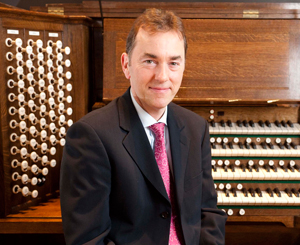by Timothy Robson
 Thomas Trotter, for the past thirty years the Birmingham (England) City Organist, appeared at the Cathedral of St. John the Evangelist in Cleveland on Tuesday evening, November 19, for a recital sponsored jointly by St. John’s Cathedral, Trinity Episcopal Cathedral and the Cleveland Chapter of the American Guild of Organists. It was an elegant and satisfying concert from beginning to end.
Thomas Trotter, for the past thirty years the Birmingham (England) City Organist, appeared at the Cathedral of St. John the Evangelist in Cleveland on Tuesday evening, November 19, for a recital sponsored jointly by St. John’s Cathedral, Trinity Episcopal Cathedral and the Cleveland Chapter of the American Guild of Organists. It was an elegant and satisfying concert from beginning to end.
In the 19th and early 20th centuries, before the invention of electronic recording devices, cities in Europe—especially in England—and the United States built large pipe organs in public auditoriums. These city-funded facilities were for the purposes of the musical education and entertainment of the citizens, especially in places where there was no symphony orchestra.
The city organist was expected to perform transcriptions of orchestral and chamber works, light and “novelty” music and patriotic marches, as well as literature written for the organ. (Indeed, Cleveland had such an organ and incumbent in the Public Auditorium downtown.) One of the most famous and still thriving public organs in England is the Birmingham Town Hall, built in 1834, where Thomas Trotter performs and records regularly. He also gives recitals on the 2001 Klais organ in Birmingham Symphony Hall.
This was a model sample of the sorts of programs a good municipal organist might give, performed on the 1948 Holtkamp organ in the rear gallery of the cathedral. The organist is normally hidden from view by the organ pipes, however, the presenters had installed a large projection video screen at the front of the nave that enabled the audience to see the performer. With a microphone, Trotter was also able to give succinct spoken program notes at several points in the program.
He opened the program with Bach’s Prelude and Fugue in G, BWV 541, with clean and concisely articulated playing and sensible tempos. Trotter demonstrated his skill in managing the cathedral’s reverberant acoustics, which can often muddy an organist’s playing.
The Bach was followed by three charming studies in canonic form by Robert Schumann in homage to Bach, originally for pedal piano. The second of the three played here, Innig, was like a song without words (or, perhaps more accurately, a vocal duet without words), lyrical, with beautiful flexibility of rhythm. The third of the canons, Nicht zu schnell, was staccato, light and ethereal, almost like a Mendelssohn scherzo.
Scottish composer Judith Weir wrote The Wild Reeds in 2013 on commission to celebrate Thomas Trotter’s 30th anniversary as Birmingham City Organist. It was an arresting work, with imaginative use of many sounds on the organ, including passages played on the portion of the organ located in the cathedral’s chancel behind the main altar, which created a striking echo effect. But still, this was recognizably a set of increasing complex variations on an improvisatory melodic line. The Wild Reeds is an attractive new addition to the organ repertoire and should be taken up by performers who are up to its challenges. Trotter gave what must be assumed to be an authoritative performance.
Excerpts from Richard Wagner’s operas have always played a significant role in the municipal organ repertoire, especially in transcriptions by the virtuoso English organist/composer Edwin H. Lemare (1866-1934), who spent his later years in the United States. Thomas Trotter performed the “Romance to the Evening Star” from Tannhäuser and “The Ride of the Valkyries” from Die Walküre. In his comments, Trotter described the latter as Lemaire’s “party piece” and “one of the most difficult five minutes of music any organist has to play.” Whatever the challenges, Trotter gave the his audience a rollicking good time, with some audience members swaying to the trilling passages and arpeggios, and others singing silently to themselves Elmer Fudd’s “Kill the wabbit, kill the wabbit.” The audience was appropriately enthusiastic at the end of the Wagner segment.
After the interval Thomas Trotter came back to play his own arrangement of Eric Coates’s masterpiece of British light music, the “Knightsbridge March,” the last movement from Coates’s 1933 London Suite. Here as elsewhere in the program, Trotter skillfully used the normally Germanic sounding organ with finesse as a somewhat reasonable facsimile of the heavier and more orchestral-sounding English organs.
The final, and major, work on the program was Julius Reubke’s Sonata: The 94th Psalm in C minor, composed, along with a piano sonata, in 1857, shortly before Reubke’s death at the age of 24 from tuberculosis. The twenty-five minute organ sonata is one of the monuments of the organ repertoire, composed in three continuous sections, inspired by the psalm, which is concerned with rage and vengeance.
An opening grave and larghetto give way to a brilliant allegro, and finally to a huge fugue, all based on a single motif heard at the beginning of the piece. In performance by a less skilled performer, it can be dull, however, in the best performances, Reubke’s masterpiece can be transcendent. Thomas Trotter easily surmounted its many technical difficulties as well as the challenge of keeping such a large, fragmentary work a unified whole. It was a remarkable conclusion to a brilliant and entertaining concert.
The audience greeted him with a deserved ovation. Trotter returned the favor with a delightful encore, a transcription of Moritz Moszkowski’s 1877 piano piece “Serenata,” which flitted along like a high-style Verdi aria.
Published on ClevelandClassical.com November 22, 2013
Click here for a printable version of this article.


